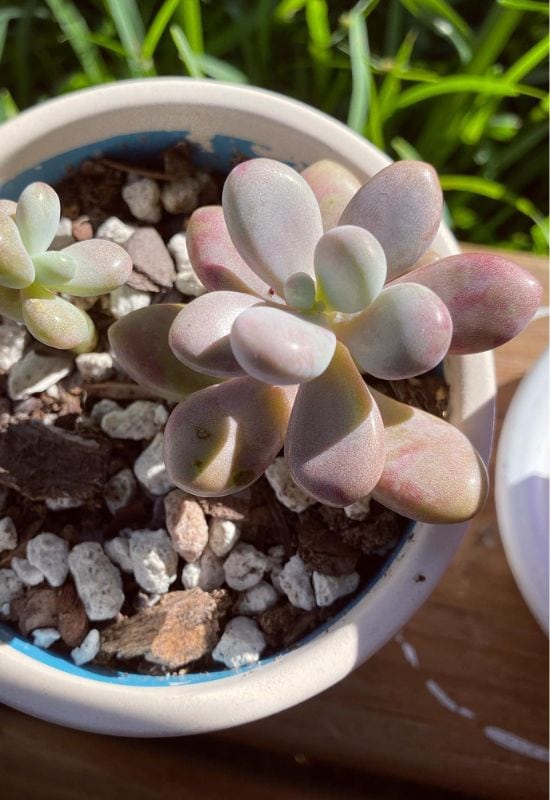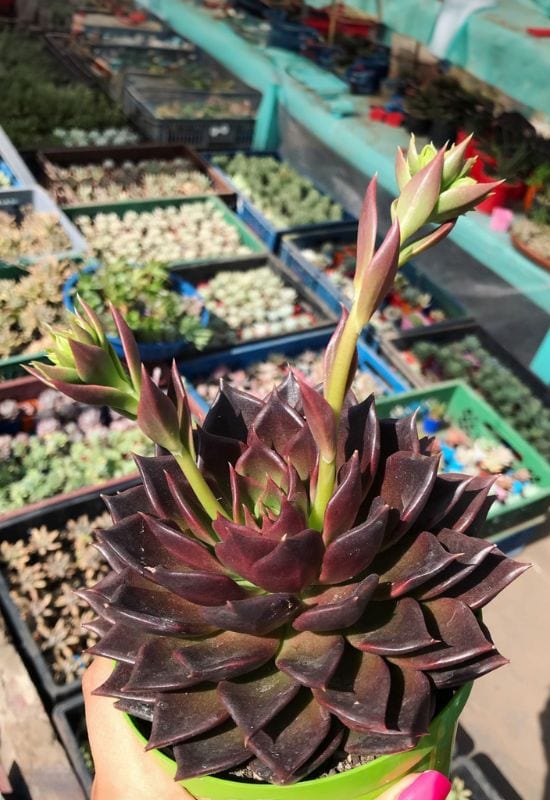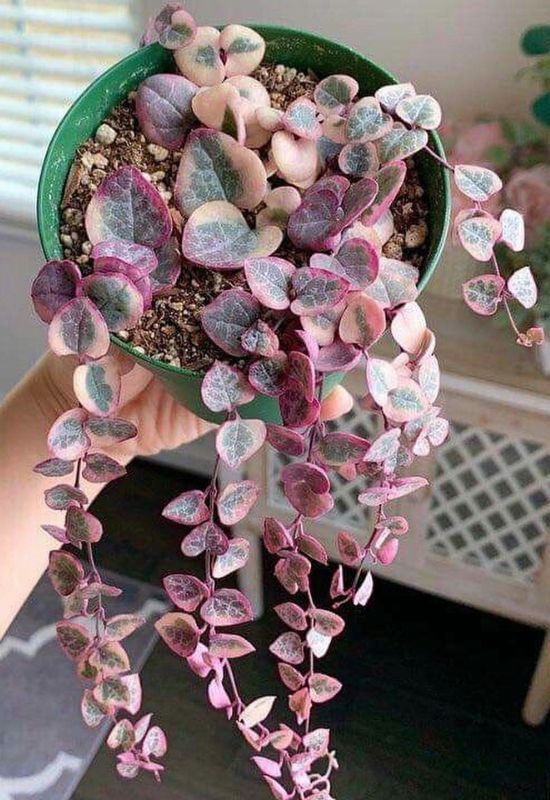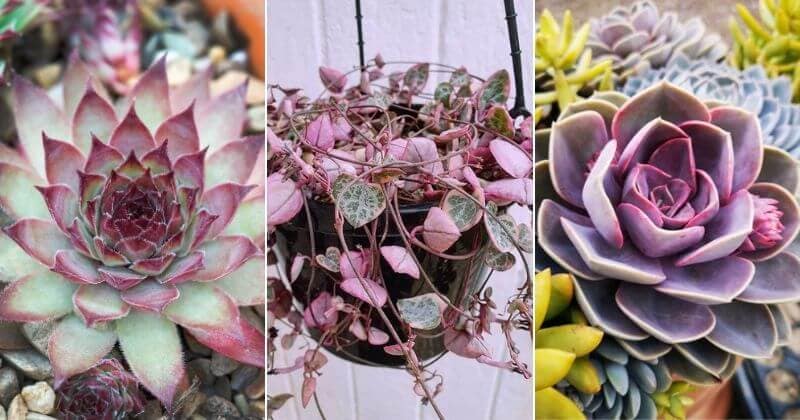
Looking to jazz up your terrariums and planters with an exciting pop of color? Then take a look at 14 enchanting purple succulents you’ll want to add to your plant family!
After all, purple is complementary to green, so you’ll be doing them a favor.
You may think these vibrant purple shades look too good to be real, but they are all living plants. Imagine all the locations in your home that could be enhanced with a pop of natural purple foliage?
In this list, you’ll discover a magical variety of shapes and shades. From ultra dark and spiky Sempervivums, through to the frosted lilac pebbles of Pachyphytum opalina. Pop them into a mixed terrarium or planter or give them a stage all to themselves.
Now let’s get started so we can introduce you to 14 of our favorite purple succulents. Of course, we’ll also share essential tips to help you keep them looking vibrant.
1: Sempervivum ‘Purple Beauty’
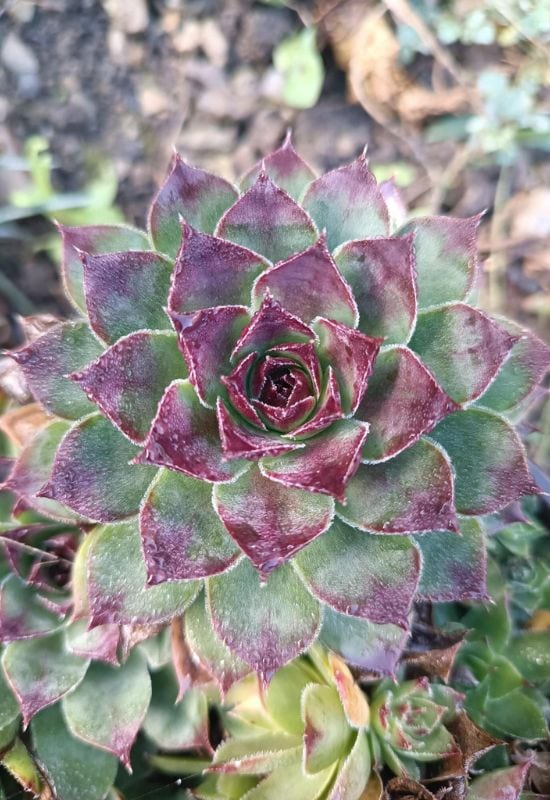
The so-called ‘common’ Houseleek is anything but boring. In fact, this succulent has a rich history! Did you know that in the past, Houseleeks growing on your roof were thought to prevent lightning from striking your home? This belief probably stems back to an even older link between Sempervivums and the Roman god of thunder, Jupiter.
Sempervivums are real survivors, getting on fine even when completely forgotten about. In the wild, they prefer poor, stony ground, so good drainage is a must.
Purple Beauty is one of the most striking varieties out there. The soft, purple-blue leaves are sure to make a lovely addition to any display.
One of Sempervivum’s many common names is ‘Hens and Chicks’. The main plant (the ‘hen’) sends off side shoots to form new plants. They look like a clutch of little chicks! You can let your Houseleek spread naturally like this or separate the chicks to replant them elsewhere. Or you could find some tiny pots and give them to friends and family as a gift.
2: Sempervivum ‘Dark Beauty’
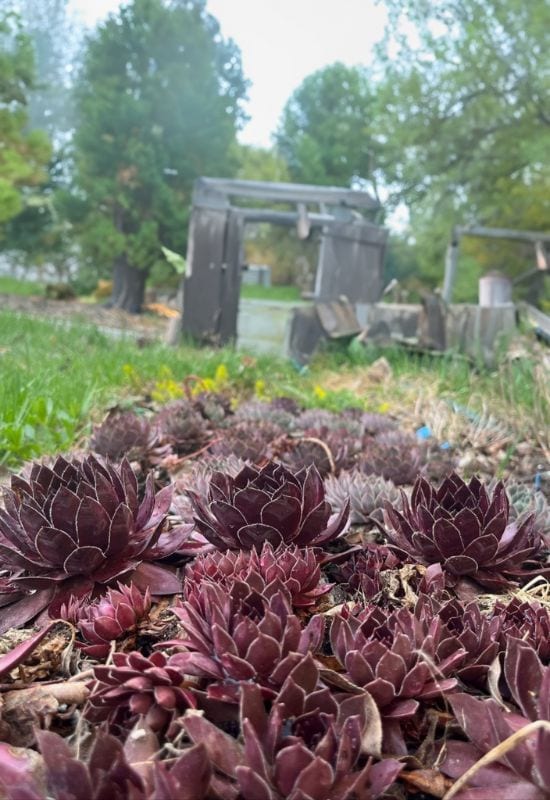
There are lots of beautiful Sempervivum varieties to choose from. ‘Dark Beauty’ is popular for it’s moody, dark purple tones. As with all Sempervivums, it’s easy to increase their numbers. Remove the baby rosettes that form around the mother and replant them.
In summer, handsome flower stalks will appear. The flowers are a delicate pink and daisy-like. Once the plant has flowered, the ‘mother’ rosette will begin to die off. Gently remove it to make space for the surrounding younger plants.
3: Wandering Jew (Tradescantia Zebrina)
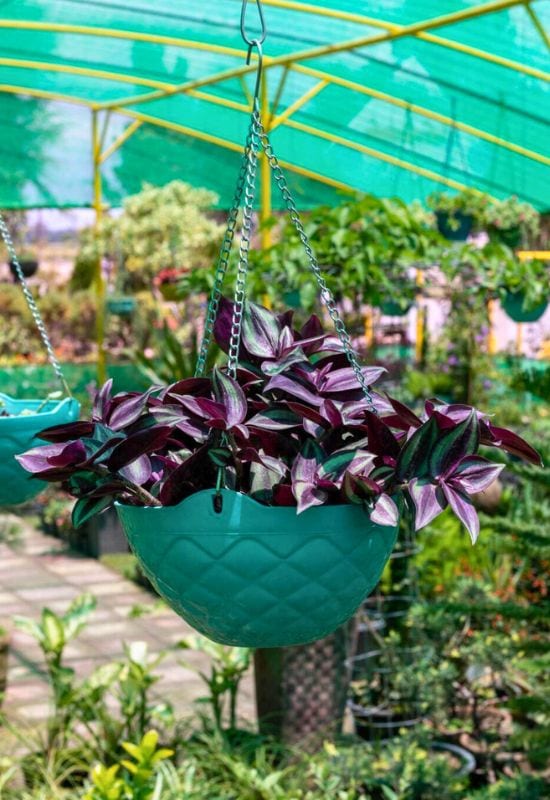
This stunning trailing plant is extremely popular, and it’s easy to see why! Zebrina’s elegant leaves clasp onto long stems that hang downwards in a luxurious cascade. From above, each leaf is a purple-tinted shade of green, with two shimmering stripes of silver. Underneath, the leaves are a pure, vibrant purple. You’ll want to hang this plant in a basket so you can appreciate it from all angles!
Tradescantia Zebrina is fast growing. Before you know it, you’ll have a gorgeous swathe of trailing leaves on display. Bright light is essential for Tradescantia to remain happy and healthy. A window that gets plenty of sunshine is the best place for it.
If you are after flowers, Tradescantia Zebrina may disappoint, as they are unlikely to flower indoors. But hey, with foliage this gorgeous, who needs flowers!?
4: Purple Heart (Tradescantia Pallida ‘Purpurea’ )
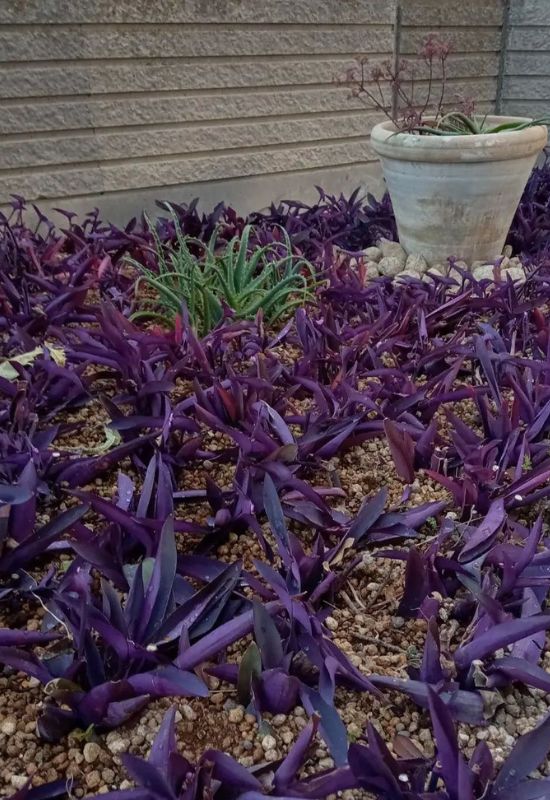
If you are already a fan of Tradescantia Zebrina, you’ll want to add a Purple Heart to your plant shopping list as well.
This jaw-droppingly beautiful plant is one of the most vibrant purple shades on our list. The stems grow upwards at first but later cascade downwards in an elegant fashion.
Purple Heart makes a perfect candidate for an eye-catching hanging basket display. In summer, you may see small, pale pink flowers appear. The blooms are very striking against the backdrop of the dark purple leaves.
To maintain the vivid purple shades, make sure your plant sits or hangs in a very sunny spot.
Unlike other succulents, Purple Heart likes to be kept moist. Don’t go overboard, however. Use a free-draining potting medium and provide a drainage hole.
5: Echeveria ‘Purple Pearl’
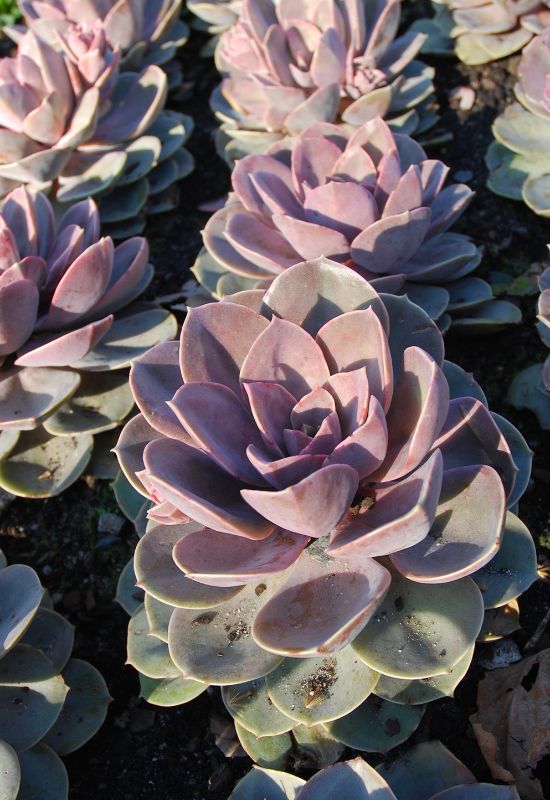
Echeveria is one of the most popular succulents around. Why? Because it’s super easy to look after! There is also a wide variety of colors to choose from.
The fleshy leaves of ‘Purple Pearl’ are a delicate, frosted purple with dainty pink edges. It’s a real understated beauty.
Originating from Mexico, this succulent needs lots of sunshine and free-draining soil to thrive. Water them sparingly in summer and hardly at all in the winter. Lots of sunlight will also help the plant maintain a warm, rosy color.
When full-grown, the rosette may reach 6” wide or more. The flowers are stunning bell-shaped blooms that appear on spikes reaching up to one foot tall.
6: Aeonium Arboreum ‘Atropurpureum’
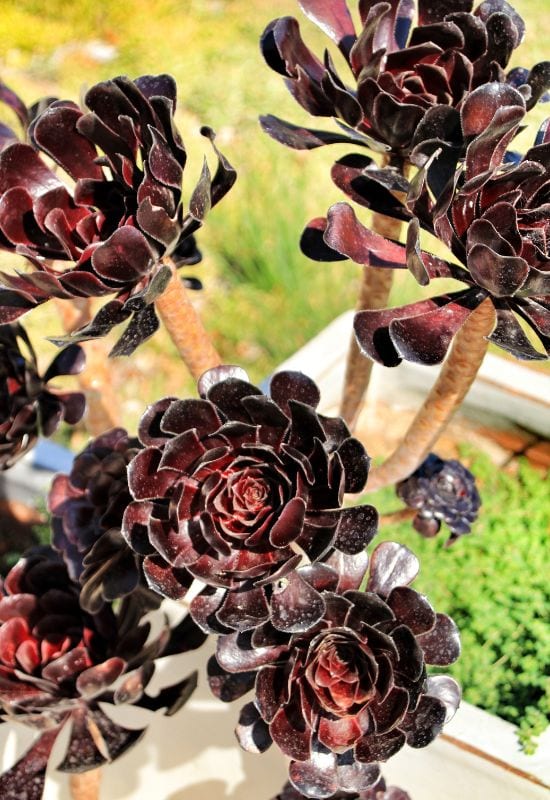
Add some drama to your house plant arrangements with Aeonium arboreum ‘Atropurpureum’. The intense, purple-black leaves are perfect for making a bold statement. Atropurpureum grows very large and works well at the back of a display. The rosettes rise up from the soil on woody stems. Use them as a foil for paler plants to create a striking effect.
Unlike many other succulents, these plants need to be kept moist (but not soggy). You may find getting the balance right a little tricky. Wintertime should mean a big reduction in water, as the plant will be entering its dormant period.
If you can provide them with a sunny position, you’ll find you have a large plant in no time. Is the Atropurpureum variety not dark enough for you? Then opt for Aeonium arboreum ‘Schwarzkopf’ instead. This variety has even darker leaves, verging on black.
7: Pachyphytum Opalina ‘Opal Moonstone’
This blushing beauty grows in rosettes of gorgeous, pebble-shaped leaves. They look a lot like a clump of pale grapes or sugared almonds. The opalescent colors of the ‘Opal Moonstone’ variety range from silvery purple to blue, pink and green.
Opalina’s leaves are covered in a powdery coating which gives them their ‘sugar almond’ appearance. This coating is called ‘fallina’ and acts as a sunscreen.
Pachyphytums are closely related to Echeverias, and their care is much the same. Don’t ever be tempted to overwater. If the plant shows signs of underwatering you needn’t worry. A good drink and it will soon perk up again.
Opalina should do extremely well indoors if left to its own devices. Find a sunny spot for your plant and use a free-draining potting medium and it will do just fine. A specialist succulent or cactus compost is recommended.
8: Echeveria ‘Black Prince’
Dark and brooding, the Black Prince makes a striking addition to any succulent display. Place a Black Prince close to bright green plants for some serious drama.
Come fall time, Black Prince will put on a thrilling display. Clusters of hot scarlet flowers appear, a stunning sight against the dark purple backdrop of the rosettes.
Like all Echeveria varieties, you’ll soon see young ‘chicks’ form as offshoots from the main rosette. You can remove and plant these elsewhere. An easy way to increase your plant family!
You’ll want to lay off the water for your Black Prince. Give it a good drink and let it dry out completely before watering again.
9: Kalanchoe Humilis
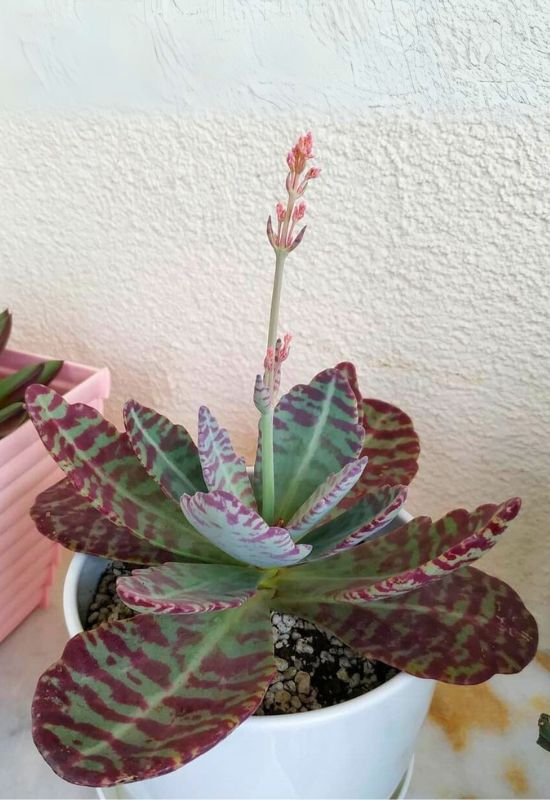
Kalanchoes are super easy to care for and ideal for beginners. Most varieties are grown for their beautiful flowers, but Kalanchoe humilis offers an added bonus. It’s gorgeous, purple and green variegated leaves provide fabulous color all year round.
Kalanchoes’ needs are minimal, and they’ll only need watering occasionally. Plant them in free-draining potting medium and sit them in a sunny location and they’re all set.
If you needed another reason to fall for this little beauty, the purple flowers that appear in summer are a favorite snack for hummingbirds!
10: Lithops Optica ‘Rubra’
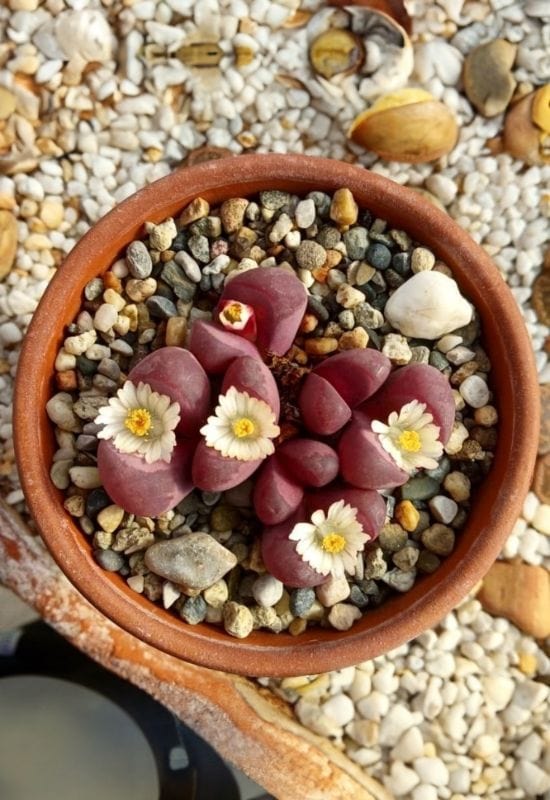
These wacky little plants have leaves that look like colorful pebbles. Every plant collection needs one or two of these unique, alien-like succulents!
Lithops optica ‘Rubra’ is a rosy pink-purple variety that forms a pair of plump leaves. They’re only a couple of inches high but over time they will create little clusters.
Come fall time, you’ll see a pretty white flower appear from the center of the leaves.
One big danger with these cute little plants is overwatering. Don’t be tempted to water during the plant’s dormant period in summer, as you’ll risk bursting the leaves.
11: Opuntia Gosseliniana
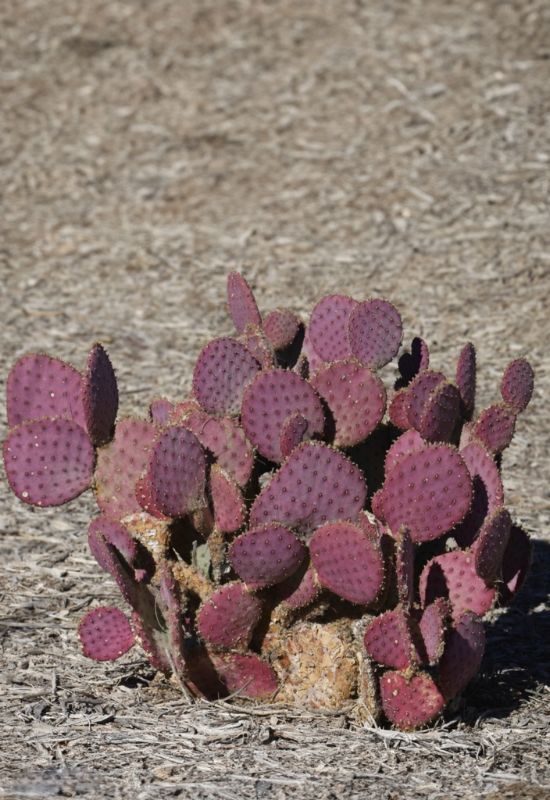
This handsome cactus is native to parts of Arizona, California, and Mexico. The large flat pads are blushed attractive shades of purple, blue, and pink. Just be careful of the sharp spines when handling them!
The Prickly Pear likes to be watered fairly frequently for a cactus, but don’t overdo it. Give them some well-draining potting medium, a drainage hole, and a sunny place to sit.
12: Sedum Dasyphyllum ‘Minor’
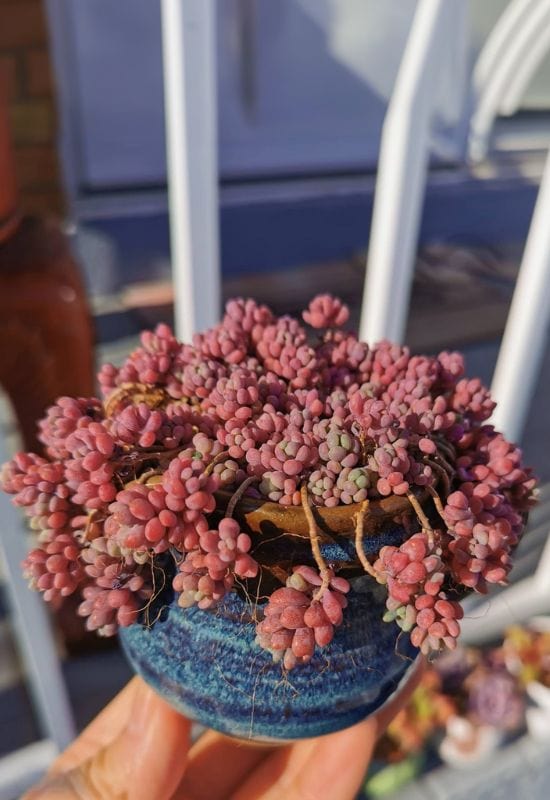
Corsican Stonecrop has delicate little leaves that form a carpet of lilac-tinged foliage.
These cute, creeping plants thrive in poor soil so when potting, make sure you use a free-draining medium. Their common name, Stonecrop, was given to them because they need as much love and attention as a stone does in order to thrive!
You’ll want to place your Corsican Stonecrop in a sunny window. If they don’t get enough sunshine, they may lose their lavender hues and revert to green.
13: Graptopetalum Pentandrum Superbum
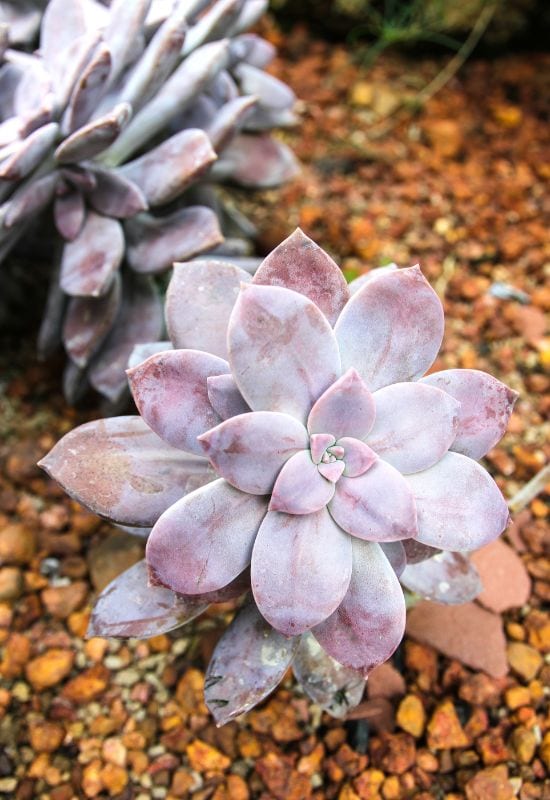
This succulent’s Latin name is a bit of a mouthful, but the ‘Beautiful Graptopetalum’ is worth hunting down to add to your plant family.
The delicate mauve-gray rosettes are attractive in their own right. But the Graptopetalum pentandrum has another impressive feature. In winter to spring, a magical display of delicate branching stems holding striking star-shaped flowers will appear. The stems of these flowers can reach up to 2 feet high!
Care for these plants is similar to other rosette succulents. Lots of sunshine, free-draining potting medium, and small amounts of water should do the trick.
14: Ceropegia Woodii Variegata
This trailing succulent is a real romantic sort! Also known as the ‘String of Hearts,’ Ceropegia woodii produces long vines with pretty, heart-shaped leaves. The leaves of this variegated variety have a blushed, pale pink-purple hue. You’ll want to pop your String of Hearts into a hanging basket to appreciate it from all angles.
Interesting Factoid: The common name ‘Rosary Vine’ comes from the little round tubers that grow along the vines.
If you love elegant trailing plants, you’ll want to add a String of Hearts to your collection. They are easy to care for, having the standard succulent requirements. Give them minimal water and lots of sunshine, and they should do fine. Just ensure you give them a rest during their winter dormancy period.

Written By
Amber Noyes
Amber Noyes was born and raised in a suburban California town, San Mateo. She holds a master’s degree in horticulture from the University of California as well as a BS in Biology from the University of San Francisco. With experience working on an organic farm, water conservation research, farmers’ markets, and plant nursery, she understands what makes plants thrive and how we can better understand the connection between microclimate and plant health. When she’s not on the land, Amber loves informing people of new ideas/things related to gardening, especially organic gardening, houseplants, and growing plants in a small space.

